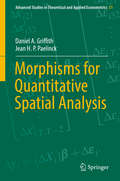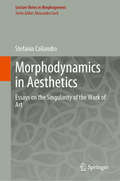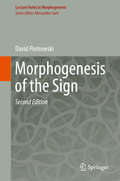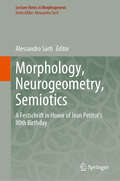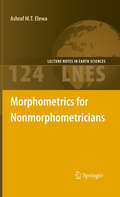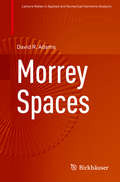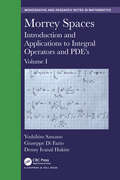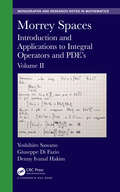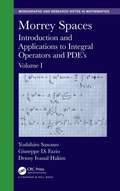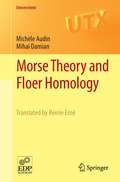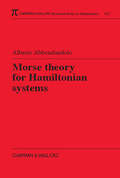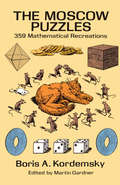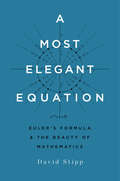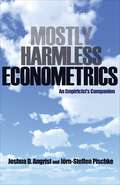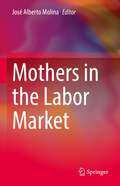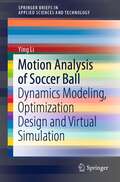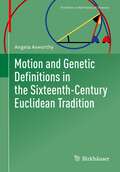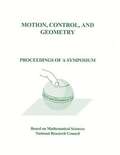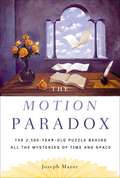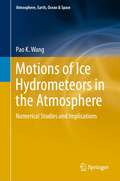- Table View
- List View
Morphisms for Quantitative Spatial Analysis (Advanced Studies In Theoretical And Applied Econometrics Ser. #51)
by Daniel A. Griffith Jean H. PaelinckThis book treats the notion of morphisms in spatial analysis, paralleling these concepts in spatial statistics (Part I) and spatial econometrics (Part II). The principal concept is morphism (e.g., isomorphisms, homomorphisms, and allomorphisms), which is defined as a structure preserving the functional linkage between mathematical properties or operations in spatial statistics and spatial econometrics, among other disciplines. The purpose of this book is to present selected conceptions in both domains that are structurally the same, even though their labelling and the notation for their elements may differ. As the approaches presented here are applied to empirical materials in geography and economics, the book will also be of interest to scholars of regional science, quantitative geography and the geospatial sciences. It is a follow-up to the book “Non-standard Spatial Statistics and Spatial Econometrics” by the same authors, which was published by Springer in 2011.
Morphodynamics in Aesthetics: Essays on the Singularity of the Work of Art (Lecture Notes in Morphogenesis)
by Stefania CaliandroThis book deals with the complexity of art by focusing on the singularity of the work of art. Gathering a selection of writings in art theory and semiotics, it explores the question of apprehending art from its perceptual aspects to aesthetic comprehension and understanding. Theoretical enquiries focus in particular on the dynamics of the perception of forms, the semiotic value of colour, the aesthetic phenomenon of empathy, the function of vision in relation to other senses and its faculty to lead, in a substantial way, to the embodiment of sense. These theoretical points are constantly observed with reference to the analysis of works of art, especially from the beginning of the modern era, when a renovated psychophysical approach oriented the evolution of contemporary aesthetics. Research into art theories sheds light on how differentials in topologic positions, dimensions, relationships and tones contribute to the arising of forms and colours in perception, and affect the perceiver. The essays presented address in different ways the emergence of sense, by conceiving it as deeply anchored to the dynamics of perception, in addition to the cognitive disposition and knowledge, regardless of whether or not the subject (artist or beholder) is aware of these processes. Through in-depth analyses identifying to what extent the aesthetic moment builds on perceptual and semiotic processes, works of art are revealed to be singularities, reflecting the correlation with morphodynamics in the sciences.
Morphogenesis of the Sign: From Morphodynamics To Neurosciences (Lecture Notes in Morphogenesis)
by David PiotrowskiThis book develops a morphodynamical approach to linguistic and sign structures as an integrated response to multilevel and interrelated problems in semiolinguistic research. More broadly, the content is linked to the realities of living speech through a connection (via the concept of diacriticity) with the Merleau-Pontian phenomenology, and beyond the formal determinations of a semiolinguistic system and its calculus. Such problems are mainly epistemological (concerning the nature and legitimate scope of semiolinguistic knowledge), empirical (concerning the observational device and the data’s composition), and theoretical (regarding the choice of a conceptual and formalized explicative frame). With regard to theory, the book introduces a morphodynamical architecture of linguistic signs and operations as a suitable mathematization of Saussurean theory. The Husserlian phenomenological signification of this formal apparatus is then established, and, from an empirical standpoint, its compatibility with neurobiological experimental results is discussed.
Morphology, Neurogeometry, Semiotics: A Festschrift in Honor of Jean Petitot 's 80th Birthday (Lecture Notes in Morphogenesis)
by Alessandro SartiJean Petitot is a polyhedric thinker whose contributions has been fundamental in a number of disciplines, such as epistemology, morphodynamics, differential geometry, structural semiotics, neurogeometry, phenomenology, linguistics, cognitive grammars, the theory of catastrophes, social sciences, literary studies, and aesthetics. This book is a homage to his huge contribution about the main concepts of morphogenesis and meaning that constitute the center of gravity around which Petitotian reflection revolves and returns.The scientific path of Jean Petitot develops between these two poles, topology and meaning. At stake it was to challenge the hiatus separating the exact sciences from the humanities that was the main point of the Petitot seminar of EHESS Epistemology of Models. By designing the appropriate qualitative dynamics between the two poles, form and meaning, it is possible to understand the Saussurian sign in structural semiotics, or the Greimasian semiotic square fordeep narrative structures or even the canonical formula of the myth of Lévi Strauss in structural anthropology. These are just few results in applying the theory of catastrophes to the emergence of meaning. The book is a collection of testimonies by distinguished authors who worked extensively with Jean Petitot in the different fields of Mathematics, Neurogeometry, Semiotics, Aesthetics, and Epistemology. An extensive bibliography of Petitot’s work is also presented.
Morphometrics for Nonmorphometricians
by Ashraf M.T. ElewaMorphometrics is concerned with the study of variations and change in the form (size and shape) of organisms or objects adding a quantitative element to descriptions and thereby facilitating the comparison of different objects and organisms. This volume provides an introduction to morphometrics in a clear and simple way without recourse to complex mathematics and statistics. This introduction is followed by a series of case studies describing the variety of applications of morphometrics from paleontology and evolutionary ecology to archaeological artifacts analysis. This is followed by a presentation of future applications of morphometrics and state of the art software for analyzing and comparing shape.
Morrey Spaces
by David R. AdamsIn this set of lecture notes, the author includes some of the latest research on the theory of Morrey Spaces associated with Harmonic Analysis. There are three main claims concerning these spaces that are covered: determining the integrability classes of the trace of Riesz potentials of an arbitrary Morrey function; determining the dimensions of singular sets of weak solutions of PDE (e. g. The Meyers-Elcart System); and determining whether there are any "full" interpolation results for linear operators between Morrey spaces. This book will serve as a useful reference to graduate students and researchers interested in Potential Theory, Harmonic Analysis, PDE, and/or Morrey Space Theory.
Morrey Spaces: Introduction and Applications to Integral Operators and PDE’s, Volume I (Chapman & Hall/CRC Monographs and Research Notes in Mathematics)
by Yoshihiro SawanoMorrey spaces were introduced by Charles Morrey to investigate the local behaviour of solutions to second order elliptic partial differential equations. The technique is very useful in many areas in mathematics, in particular in harmonic analysis, potential theory, partial differential equations and mathematical physics. Across two volumes, the authors of Morrey Spaces: Introduction and Applications to Integral Operators and PDE’s discuss the current state of art and perspectives of developments of this theory of Morrey spaces, with the emphasis in Volume I focused mainly on harmonic analysis. Features Provides a ‘from-scratch’ overview of the topic readable by anyone with an understanding of integration theory Suitable for graduate students, masters course students, and researchers in PDE's or Geometry Replete with exercises and examples to aid the reader’s understanding
Morrey Spaces: Introduction and Applications to Integral Operators and PDE’s, Volume II (Chapman & Hall/CRC Monographs and Research Notes in Mathematics)
by Yoshihiro Sawano Giuseppe Di Fazio Denny Ivanal HakimMorrey spaces were introduced by Charles Morrey to investigate the local behaviour of solutions to second order elliptic partial differential equations. The technique is very useful in many areas in mathematics, in particular in harmonic analysis, potential theory, partial differential equations and mathematical physics. Across two volumes, the authors of Morrey Spaces: Introduction and Applications to Integral Operators and PDE’s discuss the current state of art and perspectives of developments of this theory of Morrey spaces, with the emphasis in Volume II focused mainly generalizations and interpolation of Morrey spaces. Features Provides a ‘from-scratch’ overview of the topic readable by anyone with an understanding of integration theory Suitable for graduate students, masters course students, and researchers in PDE's or Geometry Replete with exercises and examples to aid the reader’s understanding
Morrey Spaces: Introduction and Applications to Integral Operators and PDE’s, Volumes I & II (Chapman & Hall/CRC Monographs and Research Notes in Mathematics)
by Yoshihiro Sawano Giuseppe Di Fazio Denny Ivanal HakimMorrey spaces were introduced by Charles Morrey to investigate the local behaviour of solutions to second order elliptic partial differential equations. The technique is very useful in many areas in mathematics, in particular in harmonic analysis, potential theory, partial differential equations and mathematical physics. Across two volumes, the authors of Morrey Spaces: Introduction and Applications to Integral Operators and PDE’s discuss the current state of art and perspectives of developments of this theory of Morrey spaces, with focus on harmonic analysis in volume I and generalizations and interpolation of Morrey spaces in volume II. Features Provides a ‘from-scratch’ overview of the topic readable by anyone with an understanding of integration theory Suitable for graduate students, masters course students, and researchers in PDE's or Geometry Replete with exercises and examples to aid the reader’s understanding
Morse Theory and Floer Homology
by Michèle Audin Mihai DamianThis book is an introduction to modern methods of symplectic topology. It is devoted to explaining the solution of an important problem originating from classical mechanics: the 'Arnold conjecture', which asserts that the number of 1-periodic trajectories of a non-degenerate Hamiltonian system is bounded below by the dimension of the homology of the underlying manifold. The first part is a thorough introduction to Morse theory, a fundamental tool of differential topology. It defines the Morse complex and the Morse homology, and develops some of their applications. Morse homology also serves a simple model for Floer homology, which is covered in the second part. Floer homology is an infinite-dimensional analogue of Morse homology. Its involvement has been crucial in the recent achievements in symplectic geometry and in particular in the proof of the Arnold conjecture. The building blocks of Floer homology are more intricate and imply the use of more sophisticated analytical methods, all of which are explained in this second part. The three appendices present a few prerequisites in differential geometry, algebraic topology and analysis. The book originated in a graduate course given at Strasbourg University, and contains a large range of figures and exercises. Morse Theory and Floer Homology will be particularly helpful for graduate and postgraduate students.
Morse Theory for Hamiltonian Systems (Chapman & Hall/CRC Research Notes in Mathematics Series)
by Alberto AbbondandoloThis Research Note explores existence and multiplicity questions for periodic solutions of first order, non-convex Hamiltonian systems. It introduces a new Morse (index) theory that is easier to use, less technical, and more flexible than existing theories and features techniques and results that, until now, have appeared only in scattered journals
The Moscow Puzzles: 359 Mathematical Recreations (Dover Recreational Math)
by Boris A. KordemskyThis is, quite simply, the best and most popular puzzle book ever published in the Soviet Union. Since its first appearance in 1956 there have been eight editions as well as translations from the original Russian into Ukrainian, Estonian, Lettish, and Lithuanian. Almost a million copies of the Russian version alone have been sold.Part of the reason for the book's success is its marvelously varied assortment of brainteasers ranging from simple "catch" riddles to difficult problems (none, however, requiring advanced mathematics). Many of the puzzles will be new to Western readers, while some familiar problems have been clothed in new forms. Often the puzzles are presented in the form of charming stories that provide non-Russian readers with valuable insights into contemporary Russian life and customs. In addition, Martin Gardner, former editor of the Mathematical Games Department, Scientific American, has clarified and simplified the book to make it as easy as possible for an English-reading public to understand and enjoy. He has been careful, moreover, to retain nearly all the freshness, warmth, and humor of the original.Lavishly illustrated with over 400 clear diagrams and amusing sketches, this inexpensive edition of the first English translation will offer weeks or even months of stimulating entertainment. It belongs in the library of every puzzlist or lover of recreational mathematics.
A Most Elegant Equation: Euler's Formula and the Beauty of Mathematics
by David StippAn award-winning science writer introduces us to mathematics using the extraordinary equation that unites five of mathematics' most important numbersBertrand Russell wrote that mathematics can exalt "as surely as poetry." This is especially true of one equation: ei(pi) + 1 = 0, the brainchild of Leonhard Euler, the Mozart of mathematics. More than two centuries after Euler's death, it is still regarded as a conceptual diamond of unsurpassed beauty. Called Euler's identity or God's equation, it includes just five numbers but represents an astonishing revelation of hidden connections. It ties together everything from basic arithmetic to compound interest, the circumference of a circle, trigonometry, calculus, and even infinity. In David Stipp's hands, Euler's identity formula becomes a contemplative stroll through the glories of mathematics. The result is an ode to this magical field.
Mostly Harmless Econometrics: An Empiricist's Companion
by Joshua D. Angrist Jörn-Steffen PischkeFrom Joshua Angrist, winner of the Nobel Prize in Economics, and Jörn-Steffen Pischke, an irreverent guide to the essentials of econometricsThe core methods in today's econometric toolkit are linear regression for statistical control, instrumental variables methods for the analysis of natural experiments, and differences-in-differences methods that exploit policy changes. In the modern experimentalist paradigm, these techniques address clear causal questions such as: Do smaller classes increase learning? Should wife batterers be arrested? How much does education raise wages? Mostly Harmless Econometrics shows how the basic tools of applied econometrics allow the data to speak.In addition to econometric essentials, Mostly Harmless Econometrics covers important new extensions—regression-discontinuity designs and quantile regression—as well as how to get standard errors right. Joshua Angrist and Jörn-Steffen Pischke explain why fancier econometric techniques are typically unnecessary and even dangerous. The applied econometric methods emphasized in this book are easy to use and relevant for many areas of contemporary social science.An irreverent review of econometric essentialsA focus on tools that applied researchers use mostChapters on regression-discontinuity designs, quantile regression, and standard errorsMany empirical examplesA clear and concise resource with wide applications
Mothers in the Labor Market
by José Alberto MolinaThis book describes the social and economic issues that emerge from mothers in labor markets. It provides insight in what the quantitative effect of motherhood on the decline in mothers’ earnings is, and how things differ for mothers with lower income and lower levels of education. It also sheds light on how this effect varies for different countries and/or cultural areas, and what the impact of socio-economic policies on mothers’ labor supply is and how it changes in different family contexts. The book covers topics such as labor participation and hours of work, paid-work and home production, flexibility and work from home, self-employment and entrepreneurship, fertility and maternity leave, wage-penalty and career interruption, labor supply and childcare, gender norms and cultural issues, intra-household wage inequality and much more. This book provides an interesting read to economists, social scientists, policy makers and HR managers and all those interested in the subject.
Motion Analysis of Soccer Ball: Dynamics Modeling, Optimization Design and Virtual Simulation (SpringerBriefs in Applied Sciences and Technology)
by Ying LiThe intelligent sports analysis of a soccer ball (also known as football, football ball, or association football ball) requires accurately simulating its motion and finding the best design parameters. Employing classic mechanics, this book establishes a fundamental framework for the soccer ball multi-body dynamics modeling, virtual prototype simulation and optimization design. It presents 3D virtual prototypes to predict the soccer ball trajectory for soccer players and trainers. Five typical case studies have addressed in the kinematics and dynamics simulations of soccer ball projectile motion, free kick, and corner kick in the virtual environment. The research on multi-body dynamics models provides a useful method for engineers and scientists to investigate the spatial kinematics and dynamics performances of various balls, such as soccer ball, gulf ball, American football, etc. The book is significant to guide undergraduate and graduate students from multi-disciplines to study system dynamics and optimization design.
Motion and Genetic Definitions in the Sixteenth-Century Euclidean Tradition (Frontiers in the History of Science)
by Angela AxworthyA significant number of works have set forth, over the past decades, the emphasis laid by seventeenth-century mathematicians and philosophers on motion and kinematic notions in geometry. These works demonstrated the crucial role attributed in this context to genetic definitions, which state the mode of generation of geometrical objects instead of their essential properties. While the growing importance of genetic definitions in sixteenth-century commentaries on Euclid’s Elements has been underlined, the place, uses and status of motion in this geometrical tradition has however never been thoroughly and comprehensively studied. This book therefore undertakes to fill a gap in the history of early modern geometry and philosophy of mathematics by investigating the different treatments of motion and genetic definitions by seven major sixteenth-century commentators on Euclid’s Elements, from Oronce Fine (1494–1555) to Christoph Clavius (1538–1612), including Jacques Peletier (1517–1582), John Dee (1527–1608/1609) and Henry Billingsley (d. 1606), among others. By investigating the ontological and epistemological conceptions underlying the introduction and uses of kinematic notions in their interpretation of Euclidean geometry, this study displays the richness of the conceptual framework, philosophical and mathematical, inherent to the sixteenth-century Euclidean tradition and shows how it contributed to a more generalised acceptance and promotion of kinematic approaches to geometry in the early modern period.
MOTION, CONTROL, AND GEOMETRY: Proceedings of a Symposium
by Board on Mathematical SciencesProceedings of a Symposium on Motion, Control, and Geometry
The Motion Paradox
by Joseph MazurThe epic tale of an ancient, unsolved puzzle and how it relates to all scientific attempts to explain the basic structure of the universe At the dawn of science the ancient Greek philosopher Zeno formulated his paradox of motion, and amazingly, it is still on the cutting edge of all investigations into the fabric of reality. Zeno used logic to argue that motion is impossible, and at the heart of his maddening puzzle is the nature of space and time. Is space-time continuous or broken up like a string of beads? Over the past two millennia, many of our greatest minds-including Aristotle, Galileo, Newton, Einstein, Stephen Hawking, and other current theoreticians-have been gripped by the mystery this puzzle represents. Joseph Mazur, acclaimed author of Euclid in the Rainforest, shows how historic breakthroughs in our understanding of motion shed light on Zeno's paradox. The orbits of the planets were explained, the laws of motion were revealed, the theory of relativity was discovered-but the basic structure of time and space remained elusive. In the tradition of Fermat's Enigma and Zero, The Motion Paradox is a lively history of this apparently simple puzzle whose solution-if indeed it can be solved-will reveal nothing less than the fundamental nature of reality.
Motions of Ice Hydrometeors in the Atmosphere: Numerical Studies and Implications (Atmosphere, Earth, Ocean & Space)
by Pao K. WangThis book summarizes unique research findings on the hydrodynamic behavior of ice particles (ice crystals, snow, graupel and hailstones) in the atmosphere. The fall behavior of ice hydrometeors determines how and how fast a mixed-phase cloud can grow or dissipate. The book discusses how the authors used computational fluid dynamics (CFD) methods and numerical simulations to determine these behaviors, and presents these computations along with numerous detailed tables and illustrations of turbulent flow fields. It also examines the implications of the results for the general atmospheric sciences as well as for climate science (since the cloud problem is the source of the greatest uncertainty in model-based climate predictions). As such it allows readers to gain a clear and comprehensive understanding of how particles fall in clouds and offers insights into cloud physics and dynamics and their impact on the climate..
Motivation Math Level 4 Texas
by Mentoring Minds Lp.Mentoring Minds' Motivation Math supplemental curriculum integrates critical thinking and process skills with classroom instruction.
Motivation MATH Level 5 Student Edition
by Mentoring MindsThis book contains a wealth of resources to motivate students to learn math at level 5.
